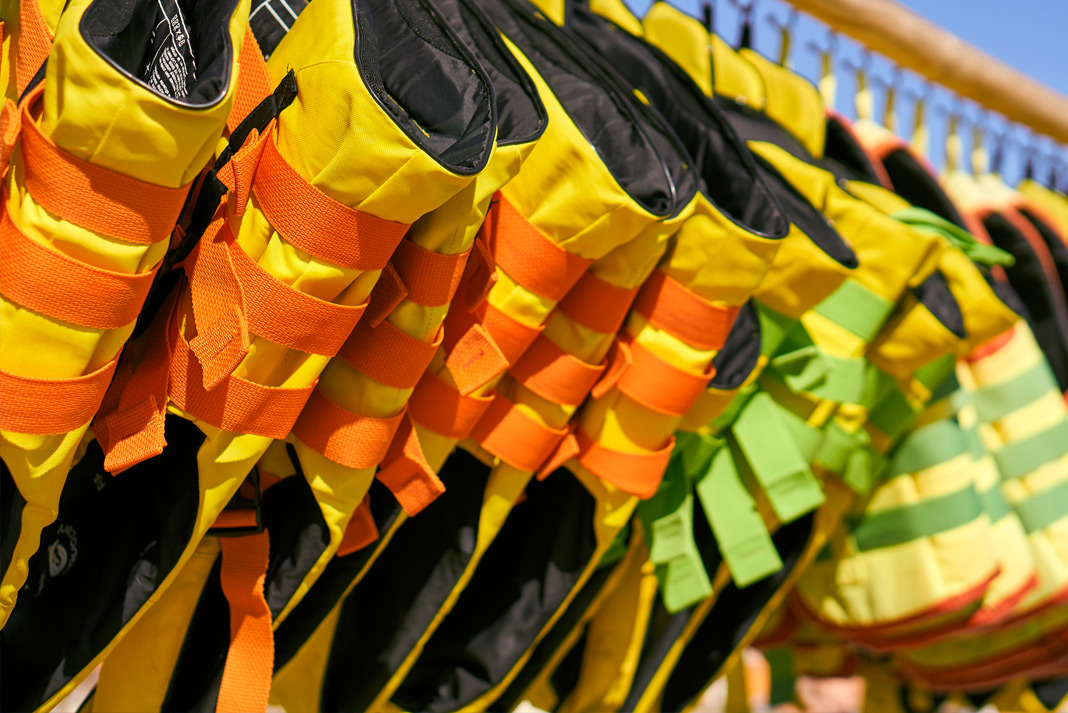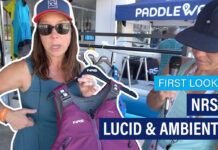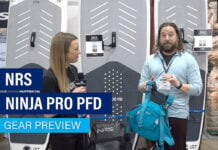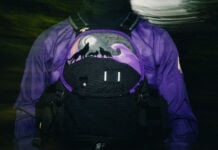If you’re new to paddling, one of the first pieces of personal equipment you’ll want to purchase is a quality personal floatation device (PFD). Floatation vests designed for paddling are comfortable to wear and have features that will enhance your experience on the water. There are dozens of paddling life jacket options to choose from, and making an informed decision can seem like a real challenge.
This article will take you through the basics so you’ll know what to expect when you stop into your local paddling shop or search for products online. Before we get started, let’s dive into some particulars of PFDs and life jacket jargon.
What is the difference between a life jacket and a PFD?
Technically speaking, a life jacket is a specific kind of PFD as classified by the US Coast Guard. If you want to stick with the exact definition, you would have to say that a life jacket is a Type I PFD for offshore ocean use. These are typically vest-style floatation devices with a large buoyant collar behind the neck. They are designed to turn an unconscious person face-up in most situations. These are big, bulky life vests that are most commonly found on commercial vessels.
Type I PFDs are not what people wear for paddlesports. They are far too bulky for comfort and their design can actually impede your ability to swim effectively in certain situations. When people talk about “life jackets” for paddling, they are almost always referring to Type III Personal Floatation Devices, which are intended as swim aids and are not designed to float an unconscious paddler face up.
If you’re talking about PFDs for paddling, it’s common to use the terms life jacket, life vest, PFD, swim vest or buoyancy aid interchangeably. If you call a paddling vest a life jacket you may not be technically correct, but everyone will know what you’re talking about. We’ll use all these terms interchangeably in this article unless we’re referencing a specific PFD type.
As you read through this article, remember that PFDs only work if you wear them. It’s important to purchase a PFD that is comfortable enough that you’ll be happy to wear it all day long. Focus on fit and comfort and be sure to wear your PFD when you’re on the water.
USCG classification
As we mentioned above, Type I PFDs are offshore ocean life jackets intended to float an unconscious paddler face-up in most situations. What about the other types of PFDs?
Type II PFDs are near shore floatation aids. These are usually the “horse collar” style PFDs that you may remember from boating as a child. Like Type I PFDs, they are designed to float an unconscious paddler face-up in most circumstances, but they are far too bulky to be comfortable for paddling.
Type III PFDs are buoyancy aids for active sports like kayaking, canoeing, SUP and sailing. They come in a vast array of designs and are far more comfortable for paddling than the bulkier Type I and Type II vests. This is the type of PFD that most paddlers will choose.
Type IV PFDs are seat cushion-shaped floatation devices that are intended to be thrown to a swimmer in an “overboard” situation. They are not intended to be worn and do not count toward mandatory PFD requirements for boaters. Type IV PFDs are an extra, backup option for larger boats.
Type V PFDs are specialized floatation devices. They may be pullover style vests with no zipper opening, whitewater rescue vests or some types of inflatables. Type V PFDs are only approved for the use for which they are certified and must be worn at all times to qualify toward minimum Coast Guard requirements.

PFD types
Now that we’ve gone over the official PFD categories, we can focus in on the particulars of the types of life jackets that paddlers use: Type III and Type V PFDs. If you start looking at these floatation vests at your local paddling store, you’ll notice they fall into a variety of different categories. There are foam-filled vests and inflatables, mesh-back vests and foam-back vests, and zipper or buckle closures on the front or side. Here’s a breakdown of the pros and cons of each of these different approaches to PFD design.
Design basics
Inflatable vs. standard
First off, let’s compare inflatable PFDs with standard, foam-filled designs. Inflatables are minimalist PFDs that only provide buoyancy when you need it. Uninflated, they are a low-profile horse-collar design or simple waist pack. Inflated, these PFDs typically resemble the Type II PFDs mentioned above.
The advantages of inflatables have mostly to do with their minimal bulk and coverage. In hot weather, an inflatable PFD will be much more comfortable than a conventional vest. Inflatables also have little bulk to get in the way of effective paddling.
Inflatables are comfortable, but they do have some disadvantages. Inflatable PFDs rely on a CO2 cartridge to fill them when needed. This cartridge should be replaced annually, and the inflation mechanism must be kept clean and corrosion free. Once inflated, inflatables place most of the buoyancy at the wearer’s chest, which can make it challenging to swim effectively in some situations. Finally, inflatable vests must be inflated to work. This means having an alert paddler who can activate the inflation mechanism or blow air into the PFD to manually inflate it.
Foam-filled PFDs provide buoyancy at all times. Those designed for paddling are comfortable to wear on the water and won’t rub you the wrong way. In cold climates, paddlers appreciate the extra insulation and warmth that a conventional PFD can provide.
Most people choose conventional, foam-filled PFDs for paddling, but inflatables win out in certain situations. If you’re paddling in hot conditions or are looking for the most minimal option available, consider an inflatable PFD. If you’re looking for the most versatile choice in a life jacket, stick with a conventional design.
Neoprene
If you search the web or visit a general outdoor store you may encounter PFDs with neoprene incorporated into their design. Neoprene is a stretchy, buoyant material used in wetsuit construction. It’s usually used in PFDs to improve fit or styling. There are a few paddlesport PFDs that incorporate neoprene into their designs, but most of the neoprene options you’ll find in the market are geared toward waterski or personal watercraft uses. Use of neoprene shouldn’t be a deciding factor in which vest you chose. Fit and function are far more important than design material specifics.
PFD design: fit and performance
Modern paddling PFDs come in a wide range of designs, but there are a few particulars that make a big difference in fit and performance. When it comes to PFD design it makes sense to focus on three main aspects: foam distribution, PFD closure style and women’s specific fit.
1. Foam distribution
All Type III PFDs are required to have 15.5 pounds of buoyancy. In that way, they’re all the same. However, where the buoyancy is placed and how it is sculpted makes a big difference in how a PFD fits. One of the biggest differences you find in foam distribution has to do with how the back of the PFD is designed. There are three main styles: mesh-back, thin-back and standard-back.
Mesh-back
Mesh-back vests are intended to be used with kayaks that have a tall backrest. In some cases, a standard foam-back PFD may bump against the top edge of a tall backrest and create some discomfort for the paddler. Mesh-back PFDs eliminate this problem by moving the foam on the back of the vest to the top of the back panel. The lower part of the panel is mesh. This design not only prevents interference with tall backrests, it also improves ventilation and comfort in hot weather.
Thin-back
Thin-back vests are another take on comfort and tall kayak backrests. Thin-back vests have, as you might imagine, thinner foam on the back panel. This means more foam needs to be placed at the front of the vest, so it may be a little bulkier than a mesh- or standard-back PFD. That being said, the thin-back design is very comfortable for many paddlers and works well with taller backrests. Depending on the paddler’s height and the height of the seat, a thin-back PFD may be more comfortable than a mesh-back design.
Standard-back
Standard-back PFDs have thicker foam on the back panel. This means foam is more evenly distributed between the back and front of the vest. The resulting PFD can feel less bulky than vests with mesh backs or thin backs. Canoeists, sea kayakers and others who don’t need a thin- or mesh-back PFD often find standard-back designs to be comfortable and effective.
2. PFD closure style
Closure style refers to the general shape of the foam panels that make up a PFD and how the paddler gets into and out of the vest. For instance, a pullover-style PFD has a single large front panel, while a front-zip PFD has two panels separated by a zipper. The three basic closure styles are front-zip, pullover and side-entry.
Front-zip
Front-zip PFDs are easy to get into and out of. They have a zipper down the middle of the front panel that allows the vest to be opened and put on like a conventional jacket. The front zipper does tend to add a little bit of bulk to these PFDs. It also limits the size of pockets that can be placed on the front of the vest. That being said, front-zip vests are favored by a majority of paddlers who enjoy the convenience of easy on and off entry.
Pullover
Pullover PFDs are minimalist designs that lack a zipper or buckle closure. They are often among the most low-profile PFD designs and are a favorite for whitewater freestyle, SUP or other activities where freedom of motion is at a premium. Because pullovers are difficult to put on while swimming, they are rated as Type V PFDs and must be worn at all times to comply with Coast Guard regulations.
Side-entry
Side-entry vests combine the fit and comfort of pullover designs with the ability to easily get into and out of the PFD. A side-zip PFD opens on one side under the armpit. To put one on, you pass one arm through the arm hole opposite the side opening and put your head through the collar area. These vests are a little trickier to put on than front-zip PFDs, but many people find them to be very comfortable.
3. Women’s fit
For years, women had to wear life jackets that were designed to fit men. Needless to say, many women found the fit of these PFDs left something to be desired. Modern women’s PFDs improve comfort by reducing pressure across the chest while still fitting securely enough for safety. The two main ways this is accomplished is through articulated design and foam sculpting.
Articulated design
Many women’s vests are sewn with a multi-panel design that articulates the foam in the front of the vest to reduce pressure across the chest. Some of these designs are reminiscent of the “princess cut” of formal ballroom gowns. The tapered shape that results from these articulated designs fits snugly around the waist and rib cage without compressing the chest.
Sculpted foam
A second approach to women’s fit is to remove some of the foam from the upper portion of the front of the PFD and redistribute it to other areas. This creates a shelf of foam that encircles the torso without compressing the chest.
Articulated design and sculpted foam are often incorporated into the same design.
Most women’s PFDs are labeled as such, but several manufacturers produce PFDs for both men and women that are based on the women’s specific fit. Frequently, the only difference is color. Turns out, many men find the articulated design of women’s PFDs to be comfortable, too. This means women who are looking for a well-fitting vest have more options than ever before.
If you are wondering if a PFD has a women’s cut, the easiest way to tell is to look at the inside of the front panel. If you see multiple panels of foam or feel an area at the top of the front panel that is thinner than the rest of the vest, odds are you have a women’s fit PFD in your hand.
Specialty life jackets
Once you understand the basics of life jacket fit, you can start digging into the details of the features that make one PFD better for a certain kind of paddling than another. Usually the difference comes down to pockets, but there are a few specialty features that come into play.
One thing to keep in mind is that many PFD manufacturers produce multiple models of PFDs based on the same PFD chassis. This means that if you find a design that fits you well, you’ll likely be able to find a version of the vest that has the type of features you want for your specific style of paddling.
Sea kayaking
Sea kayaking PFDs typically have more pockets than conventional designs. They might also have a special pocket designed to hold a VHF radio. Most have reflective material and feature multiple lash points for attaching a knife or strobe. Some sea kayaking PFDs have a provision to attach a quick-release tow belt for towing another kayaker in rescue situations.
Whitewater
Whitewater PFDs are often low-profile side-entry designs that put a premium on freedom of movement. Specialty whitewater rescue PFDs feature an integrated tow belt that can be used by well-trained kayakers for swiftwater rescue. These swiftwater rescue vests are typically Type V PFDs that must be worn at all times to comply with US Coast Guard regulations.
Fishing
Fishing PFDs have lots of pockets. They also have attachment points for lanyards, specialty holsters for pliers, and rod holders for hands-free knot tying. Many fishing PFDs feature mesh- or thin-back designs that are compatible with the tall backrests found on fishing kayaks.
SUP
You’ll be hard-pressed to find a standup paddleboard-specific PFD, but there are some features SUP paddlers gravitate toward. Most SUP paddlers prefer minimalist PFDs that offer maximum freedom of movement. Many prefer belt-style inflatable vests that need not be inflated unless the paddler is somehow separated from the paddleboard.
What size life jacket do you need?
For adults
Adult PFDs have a wide range of sizing options. All adult PFDs are required to have 15.5 pounds of buoyancy, which means any size PFD will float any adult. Fit is mostly down to how bulky a given PFD feels when worn and how much excess strap you have when things are snugged down. In some cases, the only difference between two sizes of PFD will be the length of the straps—the panels may be the same size.
PFDs should fit snugly at the waist and around the ribs so they will not slip upward over the paddler’s head. A good way to check fit is to tighten all straps and then tug gently upward on the shoulder straps. If the vest slips upward, it needs to be tightened more or isn’t a good fit for the wearer’s body type.
For kids and babies
Youth and children’s PFDs have different amounts of floatation than adult PFDs. Fit is based on weight, with children under 90 pounds wearing one size and those under 50 pounds wearing another. Infants under 30 pounds wear a third size. Make sure to purchase the correct size for your child based on weight and fit. Don’t be tempted to buy a larger size that won’t fit correctly.
Children are shaped differently than adults, so you need to pay careful attention to PFD fit. Tighten all straps and test the fit by pulling gently upward on the shoulder straps. The PFD should stay in place. If it slips upward, try another style. Some PFDs for smaller children feature a strap that fits between the legs to hold the vest down while swimming. These vests are a good choice for smaller children who might not be held securely in place by waist and chest straps.
Infant PFDs feature a collar behind the head and crotch straps to ensure the vest remains in place and the infant is supported in a face-up position in most situations.
For dogs
Dog PFDs aren’t regulated by the Coast Guard, but they are a big help if your furry friend isn’t a strong swimmer. Many feature a loop for attaching a leash and a handle on the back panel for dragging your pooch back into the canoe after a swim.
Canine PFD fit is based on chest size. Measure your dog at the broadest part of the chest and refer to the sizing chart. Fit should be snug across the chest without constriction. Fasten the neck closure so it doesn’t impede breathing or comfort.
How to properly wear a life jacket
It’s a good idea to get into the habit of correctly adjusting your PFD every time you wear it. The best way to get a secure and comfortable fit is to start with the straps of the PFD loose. When securing your PFD follow these steps:
1. Zip it
Secure the closure on the vest. If it has a zipper, zip it up. If there are only buckles, secure these.
2. Click it
Secure any remaining buckles. There is usually a buckle at the bottom of the PFD near the waist.
3. Tighten the straps
Start with the lower straps and work your way up, doing both sides at the same time. Finish by tightening the shoulder straps, if they are adjustable.
4. Check it
Check for secure fit by tugging gently upward on the shoulder straps. The PFD should remain in place and not slip upward on the torso.
The trick is to make sure your PFD is securely fitted without being so tight as to be restrictive. Remember, a PFD will only float you if you have it on. It’s important to select a PFD that is comfortable to wear so you’ll have it on should you go for an unexpected swim. Find a PFD that fits and wear it when you’re on the water.









More than a TYPE. About the new HARMONIZED LIFE JACKET APPROVALS
WHY?
Canada and the United States are working together to harmonize to one standard for life jacket approvals, allowing
the ability to use and sell the same product in both countries.
Current Life Jacket Approvals are called Legacy Type III for U.S. and Legacy PFD for Canada.
New Harmonized Life Jacket Approvals for Canada and U.S. will now be called Level 70 Buoyancy Aids
NEW LABELS/SAFETY LITERATURE
All products with the new, harmonized approval will feature a new label. The inner of the device will include sizing
information that is larger and more visible in the neckline along with the utilization of icons to specify certification level,
limitations of use, and care instructions. In addition, labeling will be tri-lingual to include English, French, and Spanish
languages.
Safety literature attached to the outer of the jacket will include a new harmonized placard. This
replaces the current “Think Safe” booklet for the U.S. and the “Wise Choice” pamphlet for Canada.
Child and youth products will have an additional Children’s Placard, which is similar to the placard currently used on
Children’s item in the U.S.
EXISTING (LEGACY) APPROVED DEVICES
Currently approved Legacy Type III (U.S.) devices will not need to be replaced and will continue to meet U.S. carriage
requirements. Devices that are approved by Transport Canada to the CGSB standard are still acceptable for use in
Canada. These are all approved for use if they are in good condition. Please read and refer to labeling for device
approval specifics. Retailers and manufacturers can continue to sell both old (legacy) and new (harmonized) devices
in the U.S. and Canada.
This informative video by the Watersports Foundation explains the Coast Guard’s new life jacket labeling system showing boaters exactly what the new label’s icons mean and how to choose a new life jacket. https://youtu.be/Oahs1ioXRZA
Good points, particularly about kids’ life jackets….go by body size/weight and not age as used to be the standard. Also, it’s important to wear your life jacket and set a good example to your kids. Also consider a grab loop or opening in the back of a smaller child’s life jacket as it can aid in pulling them up out of water. Word of caution on that zipper pull-do not attach a whistle to it as was once recommended years ago. Turbulence under water or catching on a deck line or coaming while re-entering a sea kayak can cause whistle to pull down zipper to point it can be ‘ripped’ off in those situations. Be smart, be safe, have fun out there!
Having gone overboard during a white water canoe race I can tell that it is exciting and challenging enough with out having the PFD rise up to the top of your head as you struggle to get your face above water level just to breathe and get back in your canoe. All ADULT PFD’s should come with “Anti-Submarine Straps” just as the infant and children PFD’s are equipped to provide proper use of the buoyancy designed into those PFD’s to keep their heads above water! I have modified my PFD by adding 2 “Anti-Submarine Straps” (one for each leg) enabling the inherently buoyant foam PFD to keep me afloat with my head fully out of the water. The US Coast Guard would do well in their pursuit of better water safety by advising or encouraging PFD manufacturers to add “Anti-Submarine Straps” to all PFD’s, regardless of age, weight or size.